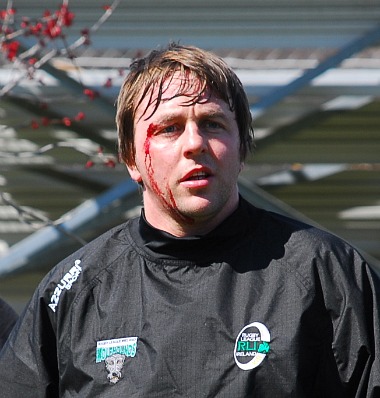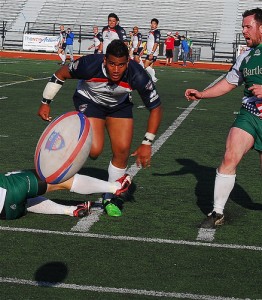
A member of the Irish Wolfhounds rugby team at practice.
They come at each other like charging rhinos, tackling each other at the chest and knees until someone is on the ground under 600 or so pounds of human flesh. All for a prize that looks like a football with a growth disorder.
It’s rugby, and it’s coming—for one day only—to Philadelphia this Saturday, March 19, reviving a tradition called The Donnybrook Cup, which pits a semi-pro/amateur team from the US against Irish players, many of whom play in the Rugby League in England.
The Tomahawks—the US National team, ranked 15th in the world—will face the Irish Wolfhounds (ranked 7th) at Charles Martin Memorial Stadium on Cottman Avenue in northeast Philadelphia, with kick-off at 4 PM (gates open at 2:30 PM). The match-up was a regular St. Patrick’s Day event until 2003, and it’s being revived this year with two teams who have met on the field six times, with the Tomahawks holding a 4-2 edge.
If you don’t think of rugby as an Irish sport—or even an American one—you’re mostly right. “Footy” is most popular in places like England—where it was born—and Australia (Aussie actor Russell Crowe owns his own rugby team). But, says Wolfhounds’ coach Alan Robinson, it’s actually the number two sport in Ireland.
“It’s second after soccer,” says Robinson, who also coaches a team in Coventry, England.
And all those rugby t-shirts you’ve seen are true: They play without protection, they have bigger balls, and they may indeed eat their dead. Well, maybe not that last one, but rugby is as tough as American football, but without helmets, pads, and multimillion dollar salaries. (Ironically, the team is sponsored by a UK insurance and risk management company, Bartlett Group.)
Here’s basically how it works in the International Rugby League:
The object of the game is to get the ball to the other end of the field (where you need to place it on the ground, a goal that gets you 4 points). That earns you the right to kick it for another 2 points. You can also kick it over the opposing goal for one point. The means by which you get there is a series of what in American football are “downs.” That’s where the kicking, running, tackling and blood happen. There are no quarterbacks with a rocket arm in this game—passing is done backwards or sideways so the player with the ball needs to stay a little ahead of his teammates. And the game lasts for 80 minutes, 40 minutes a side.
“Unlike American football, where they rest between downs, in rugby it’s continuous play,” says Robinson. “We don’t rest at all.”
That means rugby players spend more time than their American football counterparts using the cardiovascular machines at the gym, as opposed to the weights. “American footballers are big athletes, but big guys have a tougher time in rugby, you really need to be cardiovascularly fit,” Robinson explains.
Many of his players get plenty of running practice while training for their semi-pro teams. For example, Brendan Guilfoyle, team captain, plays for the Treaty City Titans in Limerick City, as do four other Wolfhounds. Some play for British teams, like the West London Sharks and Northampton Demons. Their opponents are, appropriately, multicultural, with four players from Hawaii, a New York player of Tongan descent, Salesi Tongamoa, and a team captain named Apple Pope from Florida. (Interesting side note: Pope, who has played in Australia, has two brothers, Taco and Pepci. His mother, Chili, has siblings named Peper and Cofi. It’s a long story, involving a grandmother named “Pork.” You can’t make this stuff up.)
Promoters are expecting an exciting game from two teams made up of some of the cream of the rugby crop and some up-and-comers. Fans can expect 80 minutes of pure unadulterated action. You’d be crazy not to go. About as crazy as they are to play a game where one of the most popular t-shirts reads, “Give blood. Play Rugby.”


